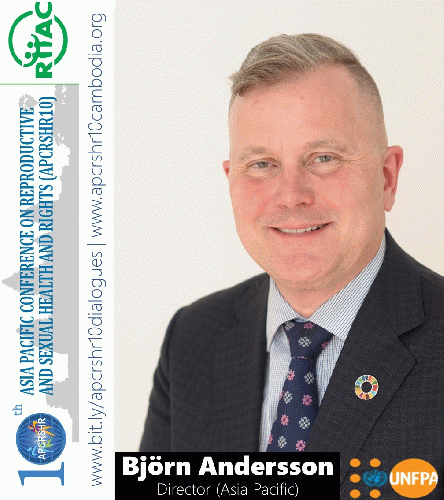
Björn Andersson, UNFPA regional director for Asia and the Pacific region
(Image by CNS (Citizen News Service citizen-news.org)) Details DMCA
Full video interview is online at: .ly/37Qn3Ew
The Nairobi Statement endorsed to mark 25 years of the 1994 International Conference on Population and Development (ICPD25) gives renewed hope and stronger thrust to gender equity and human rights. Achieving universal access to sexual and reproductive health and rights as a part of universal health coverage; zero unmet need for family planning information and services, and universal availability of quality, accessible, affordable and safe modern contraceptives; zero preventable maternal deaths and maternal morbidities; and zero gender based violence, are some of the key promises that were made last year at ICPD25.
With less than 130 months left to deliver on Sustainable Development Goals (SDGs), forthcoming 10th Asia Pacific Conference on Reproductive and Sexual Health and Rights (APCRSHR10) in Siem Reap, Cambodia, provides an opportunity to do a reality check on progress made (or lack of) on gender equality and human rights, and strategise to ensure that the region is on track to deliver on these promises.
Although there has been a 56% decrease in maternal mortality over the past 20 years, still 10 women are dying every hour in this region. As per UNFPA Report 2018 there were 127 maternal deaths per 100,000 live births and this has to be brought down to less than 70/100,000 live births by 2030 as per SDGs.
Close the gap for unmet need for family planning
Even though the use of modern methods of family planning for contraceptives has increased to 67% in the region, we still have 140 million women with unmet needs for family planning. "If we have to close the gap for unmet needs for family planning services, high quality modern contraceptives must be made accessible and affordable in a voluntary rights-based manner to all those who need them. Also healthcare providers should provide high quality counselling that is done in a very respectful and confidential manner for both men and women," said Bjà �rn Andersson to CNS (Citizen News Service).
Ensuring rights and choices for all
The ICPD Programme of Action (PoA) also says that every woman and every individual should be able to decide freely when and with whom and how many children they would like to have (or not). While increase in economic growth and development usually leads to lower fertility rate among women, it should not restrict their access to sexual and reproductive health and rights (SRHR) and family planning services.
Then again, while adolescent pregnancies have reduced overall by almost 50% (mostly due to reduction in child marriage in South Asia, especially India), the rates have stagnated or risen in many parts of South East Asia. The drivers of adolescent pregnancies in the sub-regional parts of Asia Pacific are complex indeed and a palette of interventions are needed to tackle the problem of adolescent pregnancies, said Bjà �rn Andersson of UNFPA.
"Countries must be able to ensure that there is no stigma around using modern contraceptives and that young adults/ adolescents have access to them and buy them without any fear of stigma. This is also linked to laws and policies of the countries," he added.
Zero gender-based violence is a human rights imperative
Gender based violence too is unacceptably high in the region at 21%. In the Philippines, Laos and Bhutan, it is down to 15%, but in some countries in the Pacific, especially in the island countries, it is over 60%.
In many countries of South Asia, including India, the rates of girl child marriage are coming down, which is a positive sign. But in Bangladesh, girls marrying before the age of 18 is almost 60%, in Nepal it is 40% and in Afghanistan it is 35%.
"We can never accept a pushback on our agenda" of gender equality and human rights
Asia and the Pacific is a very diverse region in terms of norms and values, economic growth and social development. It is ironical that while the region has seen tremendous economic growth during the last two decades, age old traditions, societal values and discriminatory norms have not changed much in most parts of the region. Bjà �rn Andersson is rightly concerned that inequities have increased - whether they be gender inequalities between men and women, between those living in urban and rural areas, between different groups of people like ethnic minorities or other groups who are living under vulnerable situations. In fact in many countries of the region there has been a pushback on access to sexual and reproductive health services and rights. Social conservatives have different thinking around how people should have access to sexual and reproductive health services.
(Note: You can view every article as one long page if you sign up as an Advocate Member, or higher).





